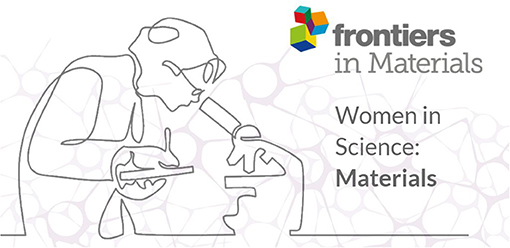- 1Department of Civil, Chemical, Environmental and Materials Engineering, University of Bologna, Bologna, Italy
- 2University of Tennessee, Space Institute, Tullahoma, TN, United States
- 3IMT Lille Douai, Institut Mines-Télécom, Univ. Lille, Centre for Materials and Processes, Douai, France
- 4Physical Chemistry Department, Institute of Materials Science, University of Alicante, Alicante, Spain
- 5School of Materials Science and Engineering, Huazhong University of Science and Technology, Wuhan, China
Editorial on the Research Topic
Women in Science: Materials
According to UNESCO Institute for Statistics (UIS) data (2019), <30% of researchers worldwide are women. Long-standing biases and gender stereotypes are discouraging girls and women away from science-related fields. In particular, STEM (science, technology, engineering, and mathematics) research is traditionally male dominated and women remain underrepresented. As UNESCO has highlighted, both science and gender equality are, however, essential to ensuring sustainable development. To change traditional mindsets, gender equality must be promoted, stereotypes defeated, and girls and women should be encouraged to pursue careers in STEM.
Throughout history, the contributions of female researchers to scientific progress have been extremely important. Yet, whereas the extraordinarily talented Nobel laureate Marie Skłodowska-Curie is often mentioned as a role model, it is nowadays well-established that countless women such as Lise Meitner have received less recognition and acknowledgment for their research findings than their male counterparts [so-called Matilda effect (Rossiter, 1993)].
Also, women traditionally publish less than men according to the European Commission She Figures, the ratio of women to men among authors of scientific publications in the EU being on the average one to two (European Union, 2019), and recent surveys are highlighting a further drop in academic submissions from female scientists since the start of the Covid-19 pandemic early 2020.
Role models are definitely extremely important to show to younger generations the growing impact of female researchers to science. Therefore, continuing the spirit of the International Day of Women and Girls in Science, Frontiers in Materials is proud to offer this platform to promote the work of female scientists across the breadth of materials science and engineering.
This inaugural “Women in Science: Materials” collection (Figure 1) aims to highlight the impact of women researchers working in materials science and engineering. It gathers a selection of original articles with the lead author and/or corresponding author being a woman.
A total of 32 contributions (three reviews, one brief research report, and 28 original research articles) present advances in theory, experiment, and methodology with applications to compelling problems, across almost all sections of the journal:
• Mechanics of materials (Bouquerel et al.; Jeong et al., TerMaath et al.; Zhu et al.)
• Smart materials (Duc et al.)
• Polymeric and composite materials (Badji et al.; Berzin et al.; Brunella et al.; Hostettler et al.; Martins and Gil; Mirbaha et al.; Padhan et al.; Quintana et al., Raj et al.; Saffar et al.)
• Carbon-based materials (Kato et al.; Moulefera et al.; Xu et al., Zhang et al.)
• Structural materials (Bonoli et al.; Boyer et al.; Korat and Ducman; Manzi et al., Masi et al.)
• Colloidal materials and interfaces (Garcia-Hernando et al.; Pucci et al.)
• Energy materials (Castro-Gutiérrez et al.)
• Ceramics and glass (Giosuè et al.)
• Environmental materials (Bassi et al.)
• Biomaterials (Criado-Gonzalez et al.; Kebaili et al.)
The Guest Editorial team hope that this collection of papers will be the foundation of an international network of women researchers working in materials science and engineering, and a starting point for future collaborations and discussions.
Author Contributions
This Editorial was jointly written by all co-authors who also served as Guest Editors for the Research Topic. All authors contributed to the article and approved the submitted version.
Conflict of Interest
The authors declare that the research was conducted in the absence of any commercial or financial relationships that could be construed as a potential conflict of interest.
References
European Union (2019). European Commission She Figures 2018. Publications Office of the European Union, Luxembourg. doi: 10.2777/936
Rossiter, M. W. (1993). The Matthew Matilda effect in science. Soc. Stud. Sci. 23, 325–341. doi: 10.1177/030631293023002004
UNESCO Institute for Statistics (2019). Women in Science (n°55) [Fact sheet], UIS/FS/2019/SCI/55, UIS Publ., Montreal, QC, Canada. Available online at: https://unesdoc.unesco.org/ark:/48223/pf0000370742
Keywords: women in STEM, women in science and engineering, materials engineering, materials science, gender equality
Citation: Bignozzi MC, Johnson JA, Krawczak P, Morallon E and Xu M (2021) Editorial: Women in Science: Materials. Front. Mater. 8:668092. doi: 10.3389/fmats.2021.668092
Received: 15 February 2021; Accepted: 25 February 2021;
Published: 23 April 2021.
Edited and reviewed by: Alberto Corigliano, Politecnico di Milano, Italy
Copyright © 2021 Bignozzi, Johnson, Krawczak, Morallon and Xu. This is an open-access article distributed under the terms of the Creative Commons Attribution License (CC BY). The use, distribution or reproduction in other forums is permitted, provided the original author(s) and the copyright owner(s) are credited and that the original publication in this journal is cited, in accordance with accepted academic practice. No use, distribution or reproduction is permitted which does not comply with these terms.
*Correspondence: Maria Chiara Bignozzi, bWFyaWEuYmlnbm96emlAdW5pYm8uaXQ=; Jacqueline Anne Johnson, ampvaG5zb25AdXRzaS5lZHU=; Patricia Krawczak, cGF0cmljaWEua3Jhd2N6YWtAaW10LWxpbGxlLWRvdWFpLmZy; Emilia Morallon, bW9yYWxsb25AdWEuZXM=; Ming Xu, bWluZy54dUBodXN0LmVkdS5jbg==
 Maria Chiara Bignozzi
Maria Chiara Bignozzi Jacqueline Anne Johnson
Jacqueline Anne Johnson Patricia Krawczak
Patricia Krawczak Emilia Morallon
Emilia Morallon Ming Xu
Ming Xu